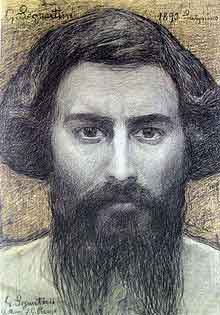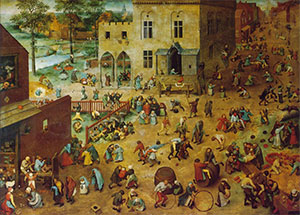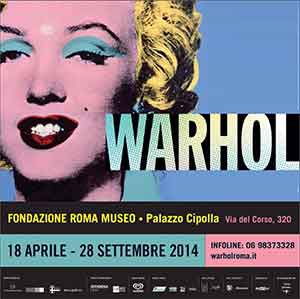Peritonitis struck Segantini’s fantastic revolution in art

By Francesco Carelli, London
Giovanni Segantini when painting in remote mountains over Maloja was struck by acute peritonitis . Help came too late and he died on 28 September 1899.
His meteoric destiny had come to an end at the age of forty-one, at the peak of the glory, leaving the world of art dumbfounded. He had chosen Maloja because of its bewitching scenery, a myth generating land to him, though undoubtedly also because of the presence of the Kursaal Palace, an exclusive hotel for the European intelligentsia and high society, hungry for art, glory and excitement. For them, during the long tourist season, Segantini had become a key figure.
Probably never displayed in Italy, Portrait of Mrs Torelli marks the end of the realistic path pursued by the artist at the beginning of his career; he had clearly assimilated the lesson of the Scapigliatura movement regarding portraiture, since the subject is is depicted as she is , without the fashionable or social trappings indicative of her status-
The nanny Buba was the artist’s favourite model for the typical Grysons woman. In these painting, the artist anticipate the Symbolist culture, projecting the portrait onto the landscape setting that both defines the person and, at the same time, embodies it.
The very well known Portrait of Carlo Rotta , commissioned by the Ospedale Maggiore in Milan, is one of the highest achievements in both Symbolist and international portraiture. The artist interprets the subject as a meditation on death, thus defying the terms of the contract, creating an allegorical dialectic between the warm light of the interior and the leaden cityscape outside the window.
In October 1881, Segantini left Milan for the Brianza area. As though seeking the last world of his early childhood, he rejected the metropolitan idea of life and art, and in the new farming world he discovered his own iconographic path. In 1886, he moved to Savognin, in the Grisons; Vittore Grubicy joined and persuaded him to experiment with a new revolutionary technique: divisionism.
This period focusing on peasant life as a genre, shows the artist’s gradual transition from a fluid, tonal style to a dense, colourist use of paint, finally replaced a pictorial texture beginning to break up into filaments under the influence of his recent conversion to Divisionism. The transition from the crepuscular landscape of Brianza to the sharp light of the Grisons was rapid, while his attention is already focused on the relationship between man and beast and on the landscape.
Segantini, even years later, re-elaborated the images of his paintings in drawing on paper: comparisons between these different versions reveal changes in focus, composition, format and light. This constant reworking of images would bring forth his naturalistic symbolism. He was aiming for a maximum fusion between reality and emotional expression. For him the level of perfection of an image depended upon its ability to communicate feeling. There were cases in which the pursue meant that he repainted a work on the same canvas, obliterating the first version even if it had already been exhibited in public, so as not to leave any trace of the original meaning.
Drawing after paintings. The importance given to the drawings on paper made from the paintings reflects both the catalyst function of reworking the image in Segantini’s oeuvre, and the importance the artist attributed to them in group exhibitions, in which the replaced canvases that could not be exhibited. They are rarely a mere replica of the oil painting, on the contrary, they go beyond a literal rendering of the original; they often alter its meaning, endowing it with symbolist overtones.
The vast landscape. They began to be antithetic to Miller’s approach and anticipate the artist’s imminent overcoming of genre painting’s limitations by subordinating humans and animals to a dominant, boundless landscape.
Sentiment and spirituality. Segantini had always been, and always would be, anticlerical, nevertheless, he had a strong spirituality – as was common among artists at the end of the 19th century. In his Brianza period Segantini was already exploring the faith of others, especially the most ingenuous kind reflected in the religious practice of common folk, but he interpreted it as the transference of harmony between humankind and the rest of creation. He is a narrative of feeling ; inEarly Mass, he replaces the female figure descending the steps with that a priest ascending them, he succeeded in completely transforming and overturning the significance of the flight of steps in Veduggio, in Brianza. He, gradually , embraces a mystic and secular pantheism, inspired by and expressed through the alpine world in a naturalist symbolism which coexisted with visionary creations based on literary sources.
“ In my heart I feel my habitual calm and in my brain a kind of confusion that is the effect of the wind. All around everything is gloomy, the sky is a dirty grey and low, an east wind is blowing, howling like a distant dying beast, the snow is on the ground, heavy and melancholy like a shroud covering the dead, the crows are all staying close to the houses, everything is turning to mud the snow is thawing “.
The vast landscape. The nature is always the protagonist, eternal and inexorably indifferent. The figures of humans or animals are simply elements necessary to the landscape into which they are assimilated, and as transient as the passing of seasons. Both the peasant woman and the cow experience the cold and sadness that descend on the upland plateau in the melancholy hour of evening.
Motherhood. Motherhood is the cornerstone of Segantini’s symbolism and the mother-nature equation lies at the heart of his narrative, because life is an eternal cycle whose periodicity affects men and animals alike. The psychoanalytical studies on the artist, all paint out to the suffered relationship to his mother, ill during his infancy and whose death left him with an unresolved trauma that was to become an obsessive theme. Segantini’s originality lies in how he perceives and expresses it, with purely naturalistic works or the oneiric ones.
Visionary works. The Angel of Life and The Evil Mothers are obviously antithetical but they deal with a single theme. The woman-mother cloaked in the holiness of a mission, that implicates the punishment of those who betray this. Segantini’s correspondence reveals a similar mother iconography also in the Pre-Raphaelite Love at the Fountain of Life, a hymn to the union between man and woman in a mythical and fertile existential spring.



